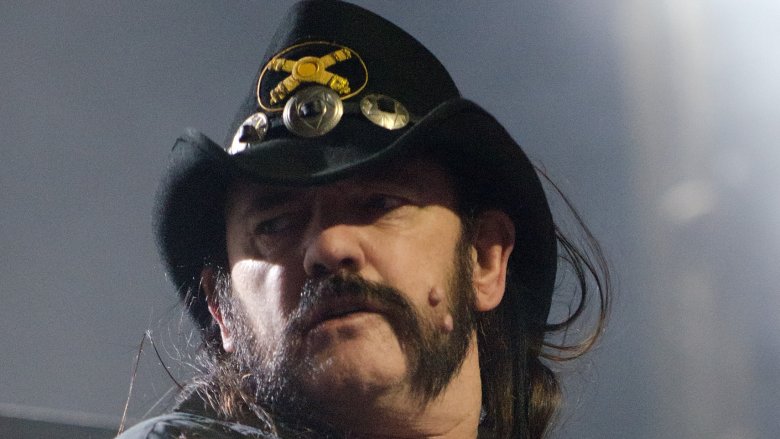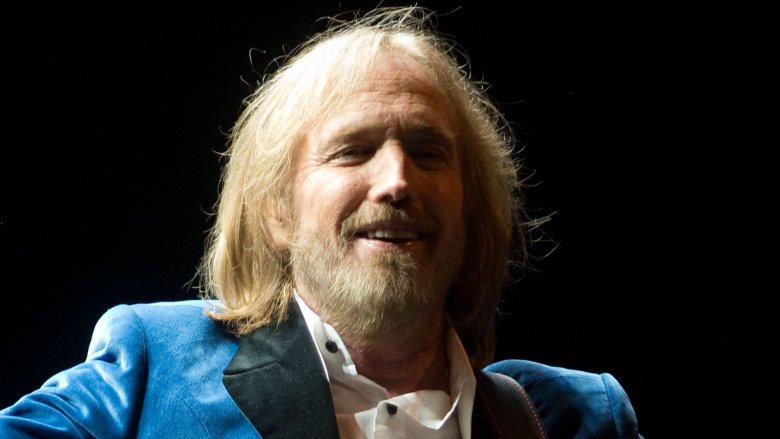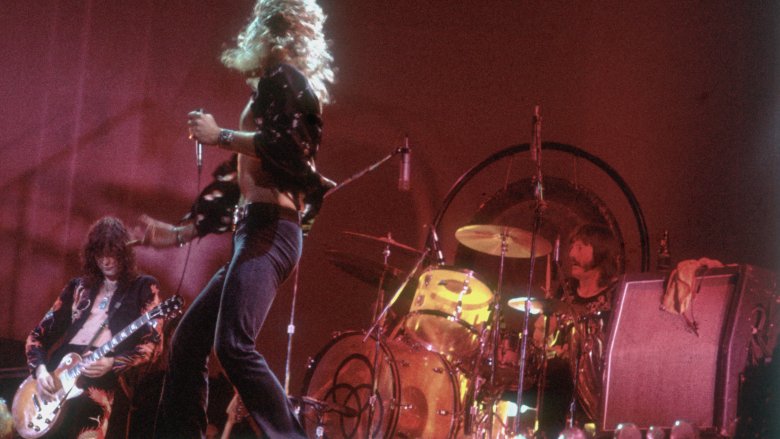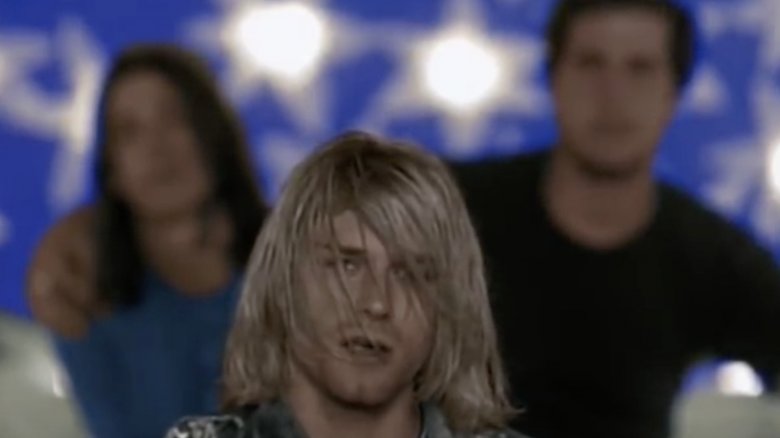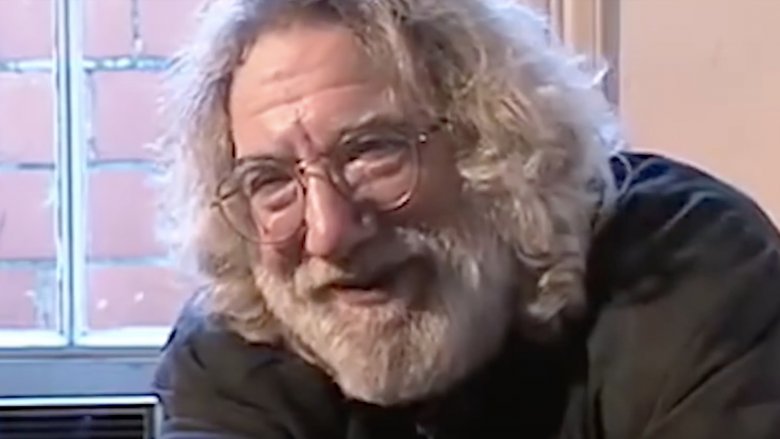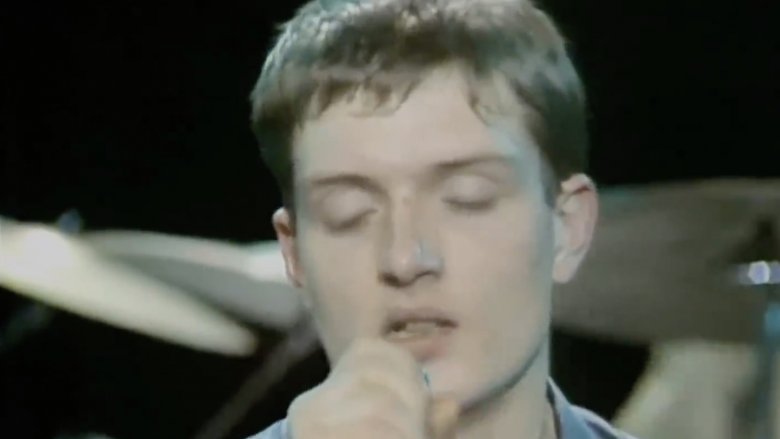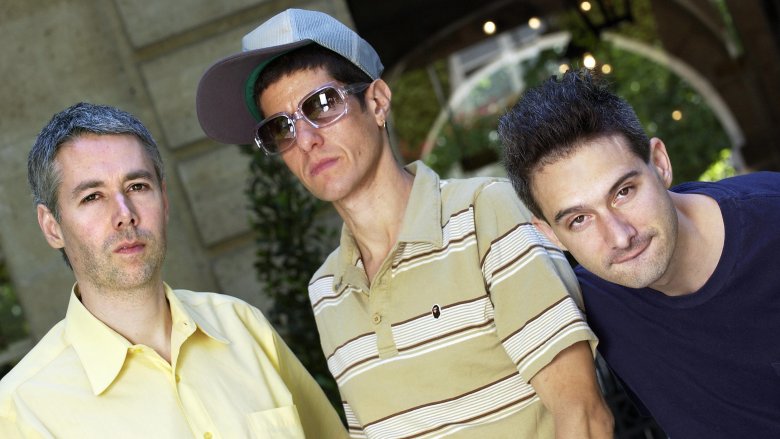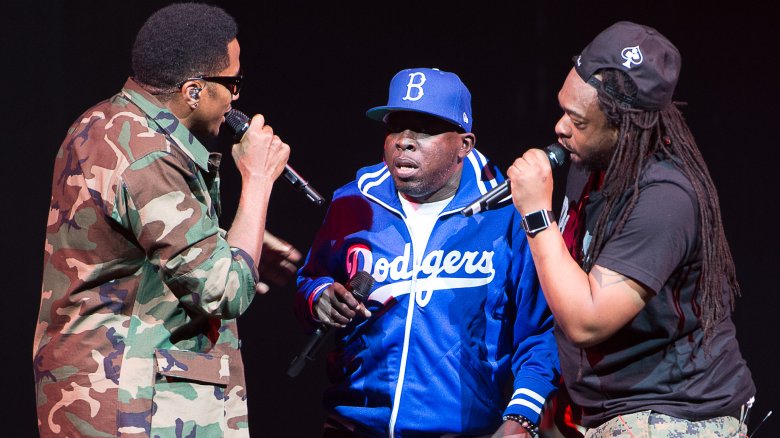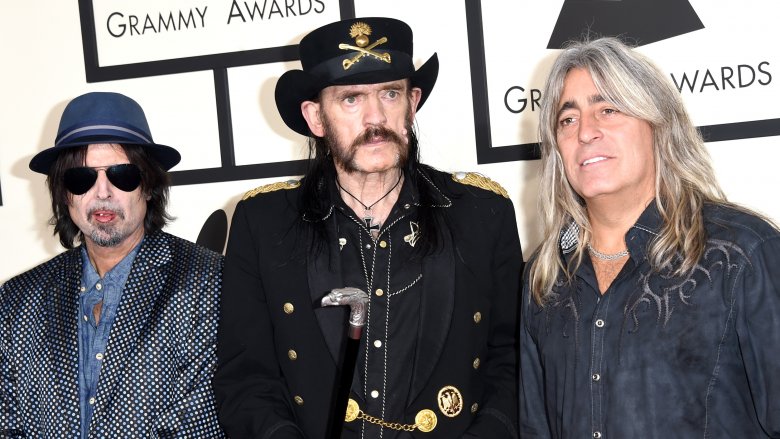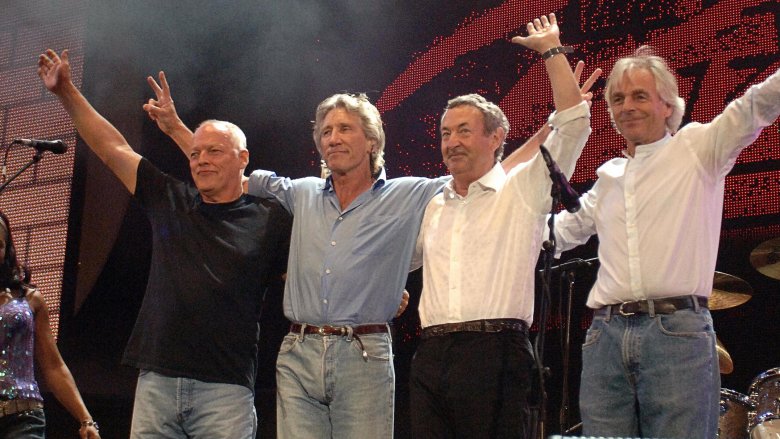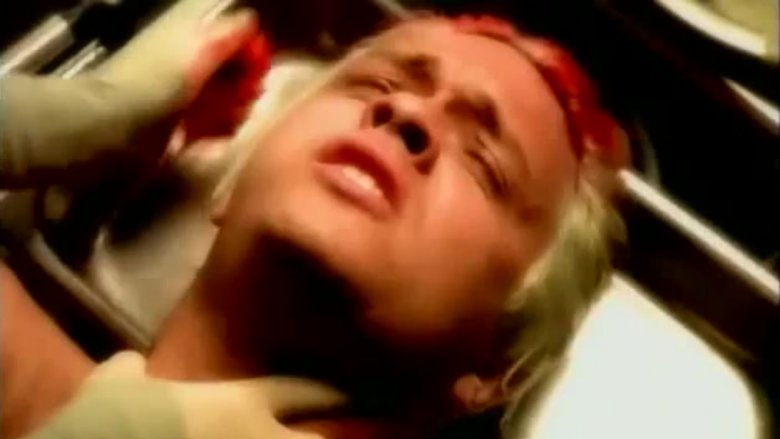Bands That Broke Up Because A Member Died
With a few notable exceptions, it's an eventual inevitability that a rock band will split up. Many are victims of their own success — their songs became so commercially successful that the pressure to make more becomes too much for the band members to bear. Or all of the money they get from being one of the biggest bands in the world — and/or the desire to acquire more of it — drives a wedge between the musicians. This is to say nothing of the other reasons why bands fall apart, like your garden variety infighting, creative differences, members pursuing solo projects, or the drummer wanting the band to try out one of their songs.
Almost as inevitable a band's breakup is the lucrative reunion tour, but there's one cause for a split that precludes bands from ever reuniting, at least in their original form. Some of the biggest bands in rock history split up — basically for good — when a member passed on to that great gig in the sky.
This one's a Heartbreaker
When a band is named after one of its members, it's hard for the rest to soldier on together after that member's death, but it's not outside the realm of possibility. After Buddy Holly famously died in a plane crash in 1959, Buddy Holly and the Crickets became the Crickets, and they carried on for decades with several different lead singers. If they'd wanted to, the Heartbreakers could have stayed together after Tom Petty passed away in 2017 — just days after finishing a huge 40th anniversary tour — but it wasn't meant to be.
In one of his last interviews, with Randy Lewis of the Los Angeles Times, Petty said the band would be taking a richly deserved break, but it wasn't supposed to be the end. "If one of us went down, or if one of us died — God forbid — or got sick..." he trailed off. "Then we'd stop. I think that would be the end of it, if someone couldn't do it." The lineup had weathered turnover before, with drummer Stan Lynch departing in the early '90s and bassist Howie Epstein exiting in 2002, but the death of Petty himself almost certainly spells the end for the Heartbreakers as a creative unit — although the surviving members were persuaded to reunite for a mini-set at a charity show in early 2018.
No Bonzo = done-so
Would classic rock radio even exist without Led Zeppelin? There's no way DJs could implore listeners to "get the Led out" without a stockpile of blues-influenced bangers like "Whole Lotta Love," "Immigrant Song," and the prototypical epic rock masterpiece "Stairway to Heaven." Part of what made Led Zeppelin so distinctive was the drumming ability of John "Bonzo" Bonham, whose volcanic riffs helped make them one of the biggest rock bands on Earth — all while he earned a reputation for the hard-partying lifestyle that would eventually kill him.
Bonham's body was discovered on September 25, 1980 at guitarist Jimmy Page's mansion in Windsor, England, where he'd spent the previous day rehearsing while knocking back quadruple vodka shots. According to the coroner's report, Bonham consumed roughly 40 servings of vodka and passed out; unable to wake when his body started to expel the booze, he inhaled his vomit and died. About ten weeks later, in December 1980, Led Zeppelin announced its split via a press release. Cause of breakup: John Bonham's death, in no uncertain terms. "We wish it to be known," wrote the group, "that the loss or our dear friend and the deep respect we have for his family, together with the sense of undivided harmony felt by ourselves and our manager, have led us to decide that we could not continue as we were."
That's a decision that's stuck, too...although Page, singer Robert Plant, and bassist/multi-instrumentalist John Paul Jones have been persuaded to briefly reunite for charity (they played with Genesis drummer Phil Collins behind the kit at 1985's Live Aid, and in 2007, Bonham's son Jason joined them for a tribute to Atlantic Records co-founder Ahmet Ertegun), and Page and Plant hooked up for a pair of Zep-adjacent LPs in the '90s. Calls for a reunion have continued, but Plant in particular has proven stubbornly unwilling to consider it.
"Led Zeppelin was an amazing, prolific fun factory for a period of time, but it was three amazing musicians and a singer living in the times. Those times," Plant said in early 2018. "That's not going to stop me doing what I'm doing now."
At least we got the Foo Fighters
Nirvana was Kurt Cobain's band through and through — he was the primary songwriter and lead singer, roles that propelled him to be proclaimed "the voice of a generation." He formed the band, made personnel decisions, and dictated the direction of the music that would make Nirvana one of the most vital rock bands of the 1990s, if not all time. Cobain's fierce ownership of the group's creative spirit threatened to derail their rise as often as it fueled it: In 1992, Cobain wrote an angry letter to the president of his record label threatening to end the band, and drummer Dave Grohl almost walked away in 1993 after he heard Cobain criticize his drumming abilities. Cobain also struggled with addiction and depression, and in 1994, he took his own life at his home in Seattle. That did it for Nirvana.
The surviving members of Nirvana sort of reunited two decades after their heyday. In 2012, Grohl and Novoselic performed with a member of another important band that famously never reunited — they served as ex-Beatle Paul McCartney's backing band on Saturday Night Live and at a Hurricane Sandy benefit after hooking up with him in the studio for a new song, "Cut Me Some Slack." When Nirvana was inducted into the Rock and Roll Hall of Fame in 2014, Grohl and Novoselic played with a series of female rock stars past and present taking on vocals, including Joan Jett, Kim Gordon of Sonic Youth, and Lorde.
What a long, strange trip it was
Is there a band more synonymous with the 1960s counterculture than the Grateful Dead? Jerry Garcia's band of merry musicians looked the part, with their long hair, huge beards, and tie-dye shirts, and provided the soundtrack of a generation with their groovy, guitar-based jam sessions that inspired a cult-like following — and similar-sounding bands with their own cult followings, such as Phish and the String Cheese Incident.
Jerry Garcia subsequently became a cultural and musical icon, leading the Dead through a nearly endless tour of 30 years; when he died, so did the Grateful Dead. In August 1995, the 53-year-old musician succumbed to a heart attack, his body weakened by numerous health problems over the years, including drug addiction and type II diabetes. Four months later, the rest of the band, including guitarist Bob Weir and drummer Mickey Hart, announced that the Dead were, well, dead. "The remaining members of the band met yesterday and came to the conclusion that the 'long strange trip' of the uniquely wonderful beast known as the Grateful Dead is over," the band said in a statement. "Although individually and in various combinations they will undoubtedly continue to make music, whatever the future holds will be something different in name and structure."
That statement proved prophetic. Although the Grateful Dead ended with Jerry Garcia's life, the surviving members have continued to move in one another's creative orbits, recording and touring under a variety of Dead-like configurations that have traded in on the group's enduring legacy. Most recently, guitarist John Mayer has joined up with a group of Dead vets for the collective dubbed Dead & Company.
Death will tear them apart
Nobody embraced the starkness and darkness of the late '70s "post-punk" movement quite like Joy Division. Combining moody lyrics and haunting instrumentation, the English band released just two albums, including Unknown Pleasures (the cover of which, a visualization of a pulsar, became a popular t-shirt), and a handful of singles, including the beloved goth classic "Love Will Tear Us Apart."
In May 1980, the band was set to embark on its first tour of the United States. They didn't make the trip — just before their planned departure, lead singer Ian Curtis was discovered dead from a self-inflicted hanging. Curtis was prone to mood swings and depression, possibly exacerbated by the powerful barbiturates prescribed for his epilepsy, which also wasn't helped by Curtis' busy and stressful life on the road. Later that year, the surviving members of Joy Division moved on together as New Order; embracing synthesizers and a somewhat sunnier approach, they became one of Britain's biggest bands of the '80s.
While the reformation was a response to a particular situation, Joy Division member Stephen Morris has speculated that a breakup probably would have happened sooner rather than later had Curtis lived. "If I'm honest, I don't think we would have carried on anyway because of Ian's illness," Morris told GQ in 2012. "I think we'd have knocked the whole thing on the head."
Listen all y'all, the Beastie Boys are over
With classics like "She's Crafty," "Hey Ladies," and "Paul Revere," the Beastie Boys helped bring hip-hop into the mainstream in the mid-1980s. The group's breakthrough album, 1986's Licensed to Ill, became the first rap record to top the Billboard charts — pretty surprising considering that the New York trio began life as a punk band when some of its members were still attending private school. From punk to hip-hop, the Boys stuck together for decades — and that bond led directly to their retirement in 2012, when founder Adam Yauch, better known as MCA, passed away from cancer at just 47 years old.
"We're done. Oh yeah. Adam Yauch started the band. It's not like a thing where we could continue without him," Adam Horovitz, a.k.a. the King Ad-Rock, told GQ in 2015. As expressed in a track off of their 1998 album Hello Nasty, the Beastie Boys considered themselves three MCs and one DJ. When one of the three MCs who had comprised the band for more than three decades passed away in 2012, they simply couldn't continue to exist.
It's not a real tribe without Phife Ddog
The hip-hop trio A Tribe Called Quest was among the most vital rap groups of the '80s and '90s thanks to forward-thinking, innovative albums like The Low End Theory and Midnight Marauders and all-time classic cuts such as "Bonita Applebaum," "Scenario," and "Can I Kick It?"
When Tribe reunited to perform on The Tonight Show in November 2015, they hadn't played together in years, and hadn't released an album since 1998, but the stars realigned; as group member Q-Tip said, "The energy for us that night was one that we hadn't experienced on stage together in some time." Sadly, member Phife Dawg died just a few months later, in March 2016, at age 45 from complications of diabetes. But he'd recorded a lot of what would wind up being the Tribe's final album, We Got It from Here... Thank You 4 Your Service.
After releasing Service in November of 2016, the "Award Tour" group took a brief victory lap, with remaining members Q-Tip and Jarobi White performing anti-gentrification anthem "We the People" on Saturday Night Live four days after the 2016 presidential election, dropping a huge mural of Phife Dawg from the stage during his verse. They played a few more concerts, the final one at Bestival 2017 in Dorset, England, when — in the middle of "Whateva Will Be" — Q-Tip told the crowd, "We lost our boy Phife Dawg. This is gonna be our last show as A Tribe Called Quest, ever."
From "Killed by Death" to killed by death
A lot of totally aggro, hardcore rock dudes contributed to the loud, fast, grimy, and anarchic sound of classic British metal band Motörhead over the years, but the face and heart of the group behind "Ace of Spades," "Overkill," and "Killed by Death" was party monster and rock legend Lemmy Kilmister. The gravel-voiced singer formed Motörhead in 1975, and he was a beloved metal icon — widely known simply as "Lemmy," particularly by such discerning tastemakers as Beavis and Butt-Head. The booze-and amphetamine-loving singer lived a fast life but still made it to the ripe old age of 70, dying from an aggressive cancer just two days after he was diagnosed in December 2015.
The end of Lemmy spelled the end for Lemmy's band. "Motörhead is over, of course. Lemmy was Motörhead," drummer Mikkey Dee told Expressen a few hours after the death of his bandmate. "We won't be doing any more tours or anything. And there won't be any more records. But the brand survives, and Lemmy lives on in the hearts of everyone."
Pink Floyd is comfortably done
Pink Floyd started off as a playful psychedelic band with songs like "See Emily Play" in the '60s under the leadership of songwriter, guitarist, and singer Syd Barrett. After Barrett left the group in 1968 due to serious mental health issues, Floyd went full-on prog rock in the 1970s and early '80s with classic LPs exploring weighty concept-driven themes, like The Dark Side of the Moon, The Wall, and Wish You Were Here.
The band frequently clashed over creative direction, with led to keyboardist Richard Wright being forced out during the sessions for The Wall, although he ultimately returned. Bassist Roger Waters wanted to do his own thing so bad that he left for a solo career in the mid-'80s; the group continued on for a decade without him, releasing the hugely popular albums A Momentary Lapse of Reason and The Division Bell, but the only time Waters ever deigned to return was for a Pink Floyd reunion show at Live 8, the 2005 climate change awareness concert.
A full Pink Floyd reunion subsequently became impossible — Barrett, who spent much of his post-Pink life in virtual seclusion, died in 2006, and Wright passed away in 2008. Drummer Nick Mason and frontman David Gilmour pieced together unreleased material to form the final Floyd album, 2014's The Endless River, but it was never meant as anything more than a belated coda. "We are done," Gilmour told Entertainment Weekly in 2015. "And it would be fakery to go back and do it again."
A Spree-ful silver lining
Led by lead singer Tim DeLaughter, Dallas-based Tripping Daisy was akin to contemporary '90s bands like Primus or Ween in that they weren't afraid of humor, a refreshing counterpoint to dour bands of the era like Smashing Pumpkins or Soundgarden. They scored a couple of memorable modern rock radio hits off their second album, I Am an Elastic Firecracker, in "I Got a Girl" and "Piranha." The follow-up, Jesus Hits Like an Atom Bomb, hit stores in 1998 and didn't garner as much attention as Elastic Firecracker; in 1999, Tripping Daisy parted ways.
It wasn't because of lackluster sales, however. In October 1999, founding member and guitarist Wes Berggren was found dead in his Dallas apartment, a demise the medical examiner's office attributed to the multiple drugs found in his system. Less than two months later, Tripping Daisy broke up.
While Tripping Daisy reunited for a few concerts in 2017, DeLaughter and others carried on in a more immediate fashion as the choral rock group the Polyphonic Spree. The well-populated collective — it's had dozens of members — became known for its cult-like white robes and uplifting songs. The Spree enjoyed a brief moment in the cultural sun in 2003–2004, when their song "Light and Day" was featured in movies and commercials, and the band itself performed on NBC's Scrubs. In 2017, DeLaughter and the other surviving members of Tripping Daisy offered fans an unexpected opportunity to revisit their legacy, reuniting for a small series of dates. They came together again in 2019 for a festival in Texas.
